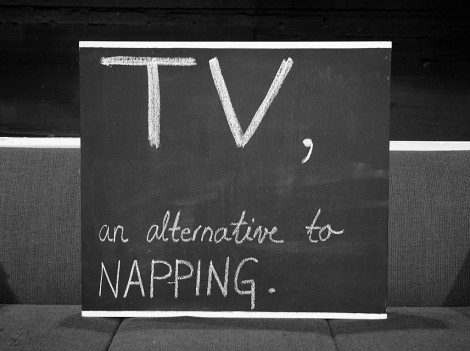17 / 06 / 2013
INSTALACIJA
IZVEDBA
TVolution will not be televised - April 14-17, Skogen, Gothenburg
Products can be attacked only with counterproducts. Television criticism must set out from the historical corpus of the medium, namely, television as an industrial enterprise. What is more, any self-determination of the viewers, as the foundation of a possible emancipatory development of television, must measure itself against this industrial dimension: that is, by what cannot automatically be detected within an individual broadcast. Television can be transformed not on the level of the individual program, but of its entire history, which determines that program.
– Oskar Negt, Alexander Kluge: Public Sphere and Experience
Television is a public medium that has seen its golden era come and go. TV was a companion to the post-war trente gloriueses of democratic welfare states. Now it is again a companion to their dismantling. Throughout the 50s, 60s, 70s and well into the 80s it was a generator of shared experience, a mitigator of a bourgeois public sphere, an ideological apparatus reinforcing political hegemony. But since that period the commodification has slowly shifted TV’s social function from a public service to a marketing machine, replacing information with entertainment, expertise and education with opinionated and partisan commentary, public interest with attention-value. At the same time the proliferation of channels and programming has fragmented the collective experience, a development that has culminated in the rise of other screen technologies that make it easy for everyone to select a programme to suit their own taste and schedule, or even to create and broadcast information of their own. However, as internet is rapidly commodifying, creating an audience-commodity of its own, internet still won’t replace the television. TV will stay with us, this public medium that has seen its golden era come and go. [caption id="attachment_1279" align="alignnone" width="470"] TVolution will not be televised[/caption]
BADco. created at SKOGEN a counterproposal to the television as we know it. BADco. set up a small-scale short-circuit television environment, fusing together in one location both the production side and the reception side of the TV medium, transforming SKOGEN into a very different kind of TV environment.
To run this TV environment we've installed our algorithmic live video system (ALVES) that was initially developed as a commission for the Croatian presentation at the 54th Venice Biennale. The custom-developed network with 6 computers and 6 cameras allows us to capture live action, to store it in a video data-base, to edit it together algorithmically, based on criteria we can set in advance, and perform various transformations during playback.
Using the system BADco. presented at SKOGEN a short feedback loop between the act of production and the act of reception. This short and closed video circuit was then opened up to performative situations, joint TV viewing and interaction with the visitors.
In this project BADco. took the inspiration from the works of early television artists. In the early days of television, before TV became a colossal commercial closed circuit, these artists tried to construct a different circuit of television production and consumption, an open one. Thus, retracing some of the critical propositions in the work of these artists in their interactive environment, we use our time at SKOGEN to reflect on the current state of television, create experimental setups and draw alternate futures for this late medium. TVolution won’t be televised, its alternate evolution might however get performed.
TVolution will not be televised was is run using the algorithmic live video system (ALVES) that was developed in collaboration with the German human-machine interface developer Daniel Turing. The performative installation presented in Gothenburg in April 2013 was a work in progress for BADco.’s forthcoming theatre performance A Pound of Hysteria, Acceleration… - melodrama premiered in October 2013.
TVolution will not be televised[/caption]
BADco. created at SKOGEN a counterproposal to the television as we know it. BADco. set up a small-scale short-circuit television environment, fusing together in one location both the production side and the reception side of the TV medium, transforming SKOGEN into a very different kind of TV environment.
To run this TV environment we've installed our algorithmic live video system (ALVES) that was initially developed as a commission for the Croatian presentation at the 54th Venice Biennale. The custom-developed network with 6 computers and 6 cameras allows us to capture live action, to store it in a video data-base, to edit it together algorithmically, based on criteria we can set in advance, and perform various transformations during playback.
Using the system BADco. presented at SKOGEN a short feedback loop between the act of production and the act of reception. This short and closed video circuit was then opened up to performative situations, joint TV viewing and interaction with the visitors.
In this project BADco. took the inspiration from the works of early television artists. In the early days of television, before TV became a colossal commercial closed circuit, these artists tried to construct a different circuit of television production and consumption, an open one. Thus, retracing some of the critical propositions in the work of these artists in their interactive environment, we use our time at SKOGEN to reflect on the current state of television, create experimental setups and draw alternate futures for this late medium. TVolution won’t be televised, its alternate evolution might however get performed.
TVolution will not be televised was is run using the algorithmic live video system (ALVES) that was developed in collaboration with the German human-machine interface developer Daniel Turing. The performative installation presented in Gothenburg in April 2013 was a work in progress for BADco.’s forthcoming theatre performance A Pound of Hysteria, Acceleration… - melodrama premiered in October 2013.
17 / 06 / 2013
INSTALACIJA
IZVEDBA
TVolution will not be televised - April 14-17, Skogen, Gothenburg
Products can be attacked only with counterproducts. Television criticism must set out from the historical corpus of the medium, namely, television as an industrial enterprise. What is more, any self-determination of the viewers, as the foundation of a possible emancipatory development of television, must measure itself against this industrial dimension: that is, by what cannot automatically be detected within an individual broadcast. Television can be transformed not on the level of the individual program, but of its entire history, which determines that program.
– Oskar Negt, Alexander Kluge: Public Sphere and Experience
Television is a public medium that has seen its golden era come and go. TV was a companion to the post-war trente gloriueses of democratic welfare states. Now it is again a companion to their dismantling. Throughout the 50s, 60s, 70s and well into the 80s it was a generator of shared experience, a mitigator of a bourgeois public sphere, an ideological apparatus reinforcing political hegemony. But since that period the commodification has slowly shifted TV’s social function from a public service to a marketing machine, replacing information with entertainment, expertise and education with opinionated and partisan commentary, public interest with attention-value. At the same time the proliferation of channels and programming has fragmented the collective experience, a development that has culminated in the rise of other screen technologies that make it easy for everyone to select a programme to suit their own taste and schedule, or even to create and broadcast information of their own. However, as internet is rapidly commodifying, creating an audience-commodity of its own, internet still won’t replace the television. TV will stay with us, this public medium that has seen its golden era come and go. [caption id="attachment_1279" align="alignnone" width="470"] TVolution will not be televised[/caption]
BADco. created at SKOGEN a counterproposal to the television as we know it. BADco. set up a small-scale short-circuit television environment, fusing together in one location both the production side and the reception side of the TV medium, transforming SKOGEN into a very different kind of TV environment.
To run this TV environment we've installed our algorithmic live video system (ALVES) that was initially developed as a commission for the Croatian presentation at the 54th Venice Biennale. The custom-developed network with 6 computers and 6 cameras allows us to capture live action, to store it in a video data-base, to edit it together algorithmically, based on criteria we can set in advance, and perform various transformations during playback.
Using the system BADco. presented at SKOGEN a short feedback loop between the act of production and the act of reception. This short and closed video circuit was then opened up to performative situations, joint TV viewing and interaction with the visitors.
In this project BADco. took the inspiration from the works of early television artists. In the early days of television, before TV became a colossal commercial closed circuit, these artists tried to construct a different circuit of television production and consumption, an open one. Thus, retracing some of the critical propositions in the work of these artists in their interactive environment, we use our time at SKOGEN to reflect on the current state of television, create experimental setups and draw alternate futures for this late medium. TVolution won’t be televised, its alternate evolution might however get performed.
TVolution will not be televised was is run using the algorithmic live video system (ALVES) that was developed in collaboration with the German human-machine interface developer Daniel Turing. The performative installation presented in Gothenburg in April 2013 was a work in progress for BADco.’s forthcoming theatre performance A Pound of Hysteria, Acceleration… - melodrama premiered in October 2013.
TVolution will not be televised[/caption]
BADco. created at SKOGEN a counterproposal to the television as we know it. BADco. set up a small-scale short-circuit television environment, fusing together in one location both the production side and the reception side of the TV medium, transforming SKOGEN into a very different kind of TV environment.
To run this TV environment we've installed our algorithmic live video system (ALVES) that was initially developed as a commission for the Croatian presentation at the 54th Venice Biennale. The custom-developed network with 6 computers and 6 cameras allows us to capture live action, to store it in a video data-base, to edit it together algorithmically, based on criteria we can set in advance, and perform various transformations during playback.
Using the system BADco. presented at SKOGEN a short feedback loop between the act of production and the act of reception. This short and closed video circuit was then opened up to performative situations, joint TV viewing and interaction with the visitors.
In this project BADco. took the inspiration from the works of early television artists. In the early days of television, before TV became a colossal commercial closed circuit, these artists tried to construct a different circuit of television production and consumption, an open one. Thus, retracing some of the critical propositions in the work of these artists in their interactive environment, we use our time at SKOGEN to reflect on the current state of television, create experimental setups and draw alternate futures for this late medium. TVolution won’t be televised, its alternate evolution might however get performed.
TVolution will not be televised was is run using the algorithmic live video system (ALVES) that was developed in collaboration with the German human-machine interface developer Daniel Turing. The performative installation presented in Gothenburg in April 2013 was a work in progress for BADco.’s forthcoming theatre performance A Pound of Hysteria, Acceleration… - melodrama premiered in October 2013.

